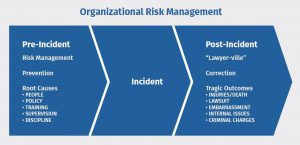Editor’s note: This article is part of a series. Click here for the previous article.
Gordon Graham here and thanks for taking the time to read this next iteration in my series on what “real risk management” is all about. The tough thing about this series is that many of you have been reading from the start, but some of you have just joined us and are reading this as a solo work. Although I design each of these writings to stand alone, I encourage you to read the series if you can find the time (here’s a link to the first article).
Enough on that.
The overall goal of these articles is to familiarize you with the 10 Families of Risk that you face in public safety operations, and to get you thinking about the control measures you need to have in place to address these risks. If you go back to the start of this article series, I have given you some thoughts on external risks, legal and regulatory risks, strategic risks and, in the last few articles, some organizational risk management. Here is a repeat of the graphic I used to start this discussion.
We addressed the “policy” component in my last article—and a sincere thank-you for your kind emails regarding that article, as well as for those of you who are Lexipol client agencies. Now it is time to move onto the “training” pillar.
Public safety training can be put into three separate (but hopefully complementary) components: initial academy-based training, training provided to probationary employees (also referred to as the field training officer, or FTO, process in law enforcement) and continued professional training.
Let’s start with initial training. While there’s always room for improvement, I feel confident most academies and initial training programs are doing a good job preparing law enforcement officers, corrections officers and firefighters. It is my belief that initial training needs to be viewed as a foundation for everything that follows, but I also believe there needs to be a thread throughout all training focusing on the “core critical tasks” in every job description in public safety. More on core critical tasks in just a bit.
“I hear this over and over again around the U.S.—field training is a ‘problem lying in wait.’”
My worries with training start with probationary training. On a national level I have concerns about it. Here we are in 2018 and I still talk to cops and firefighters fresh out of the academy who are greeted by an FTO or company officer or veteran firefighter who tells the young graduate, “Forget everything you learned at the academy—just listen to me and you will be fine.”
I hope that is not going on in your department but before you jump to reassure me, ask yourself this: How do you know it’s not? I hear this over and over again when I talk to program attendees around the U.S.—field training is a “problem lying in wait” (if that term is new to you, consult the earlier articles in this series). Please make sure your FTOs understand what their role is in the training process.
Let’s move onto to the third component of training—ongoing training. Here is a scary thought for your consideration: After a young cop or a firefighter in your department graduates the academy or completes whatever initial training is required—and assuming they do not attempt to promote within your agency—when is the next time they must take a serious test for which they must study? How do you know what your people really know about their core critical tasks prior to their involvement in an incident?
Many of you reading this are police chiefs and senior executives in corrections. Downstream in litigation you are going to be on the stand as a named defendant in a lawsuit and you are going to be asked this question: “Chief, when was the last time this officer (the defendant who is the focus of a lawsuit) was trained and tested on the use of force policy?”
What will your answer be, Chief?
For those leaders in the fire service, someday you may face a lawsuit involving retaliation against an employee who is a member of a protected class. And when that happens, you’ll be asked this question: “Chief, when was the last time your discriminatory harassment policy was updated? And can you produce training records to show your firefighters know and understand this policy?”
What will your answer be, Chief?
The sad news is that, too often, the only time you find out that your officers or firefighters don’t know the shooting policy or the inmate safety checks policy or the social media policy is AFTER the incident occurs and it ends up in a tragedy. There has got to be a better way to train our personnel—and that will be our focus in the next piece in this series.

